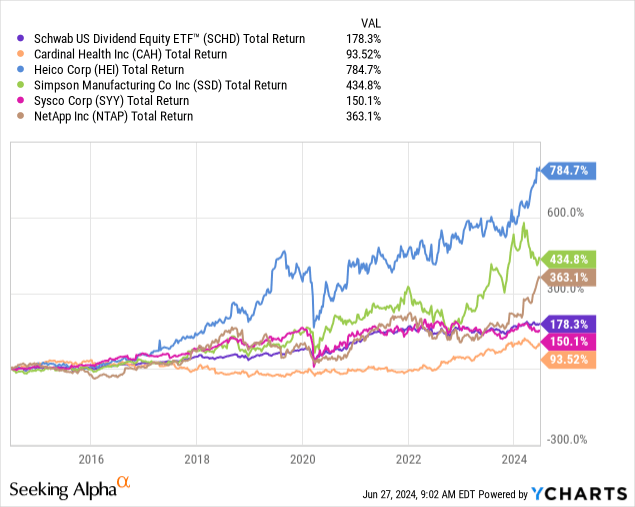Welcome back to another edition of upcoming dividend increases. We are starting July’s increases. If you are trading, be aware of the modified market hours next week. The market will close at 1 p.m. EST on the 3rd and be closed on July 4th. We also have dividend king Sysco Corporation extending its 54-year streak with a 2% increase. The overall group of companies has an average increase of 4.1% and a median of 3.7%.
My investment strategy involves buying, holding, and adding to companies that meet two criteria: consistently increasing their dividends and beating an equivalent benchmark. The information in this article is generated for my investing needs, and I’m happy to share my findings with my Seeking Alpha audience. This list can help you make wise investment choices and create a successful long-term portfolio.
How I Created The Lists
The following information is a result of merging two sources of data: the “U.S. Dividend Champions” spreadsheet from a particular website and upcoming dividend data from NASDAQ. This process combines data on companies with a consistent dividend growth history with future dividend payments. It’s important to understand that all companies included in this list have consistently grown their dividends for at least five years.
Companies must have higher total yearly dividends to be included in this list. Therefore, a company may not increase its dividend every calendar year, but the total annual dividend can still grow.
What Is The Ex-Dividend Date?
The ex-dividend date is when you must own shares to qualify for an upcoming dividend or distribution. To be eligible, you must have bought the shares by the end of the preceding business day. For instance, if the ex-dividend date is Tuesday, you must have acquired the shares by the market close on Monday. If the ex-dividend date falls on a Monday (or a Tuesday following a holiday on Monday), you must have purchased the shares by the previous Friday.
Dividend Streak Categories
Here are the definitions of the streak categories, as I’ll use them throughout the piece.
- King: 50+ years.
- Champion/Aristocrat: 25+ years.
- Contender: 10–24 years.
- Challenger: 5+ years.
| Category | Count |
| King | 1 |
| Champion | 1 |
| Contender | 3 |
| Challenger | 0 |
The Dividend Increases List
Data was sorted by the ex-dividend date (ascending) and then by the streak (descending):
| Name | Ticker | Streak | Forward Yield | Ex-Div Date | Increase Percent | Streak Category |
| Cardinal Health, Inc. | (CAH) | 29 | 2 | 1-Jul-24 | 1.00% | Champion |
| Heico Corporation | (HEI) | 20 | 0.1 | 1-Jul-24 | 10.00% | Contender |
| Simpson Manufacturing Company, Inc. | (SSD) | 11 | 0.66 | 3-Jul-24 | 3.70% | Contender |
| Sysco Corporation | (SYY) | 54 | 2.82 | 5-Jul-24 | 2.00% | King |
| NetApp, Inc. | (NTAP) | 10 | 1.56 | 5-Jul-24 | 4.00% | Contender |
Field Definitions
Streak: Years of dividend growth history are sourced from the U.S. Dividend Champions spreadsheet.
Forward Yield: The payout rate is calculated by dividing the new payout rate by the current share price.
Ex-Dividend Date: This is the date you need to own the stock.
Increase Percent: The percent increase.
Streak Category: This is the company’s overall dividend history classification.
Show Me The Money
Here is a table that shows the new and old rates and the percentage increase. The table is sorted by ex-dividend day in ascending order and dividend streak in descending order.
| Ticker | Old Rate | New Rate | Increase Percent |
| CAH | 0.501 | 0.506 | 1.00% |
| HEI | 0.1 | 0.11 | 10.00% |
| SSD | 0.27 | 0.28 | 3.70% |
| SYY | 0.5 | 0.51 | 2.00% |
| NTAP | 0.5 | 0.52 | 4.00% |
Additional Metrics
Some different metrics related to these companies include yearly pricing action and the P/E ratio. The table is sorted the same way as the table above.
| Ticker | Current Price | 52-Week Low | 52-Week High | PE Ratio | % Off Low | % Off High |
| CAH | 101.09 | 83.83 | 115.52 | 16.75 | 21% Off Low | 12% Off High |
| HEI | 225.27 | 155.33 | 232.02 | 55.16 | 45% Off Low | 3% Off High |
| SSD | 169.03 | 123.59 | 218.08 | 21.48 | 37% Off Low | 22% Off High |
| SYY | 72.28 | 61.43 | 82.37 | 0 | 18% Off Low | 12% Off High |
| NTAP | 128.45 | 69.67 | 130.87 | 19.79 | 84% Off Low | 2% Off High |
Tickers By Yield And Growth Rates
I’ve arranged the table in descending order for investors prioritizing the current yield. As a bonus, the table also features some historical dividend growth rates. Moreover, I have incorporated the “Chowder Rule,” which is the sum of the current yield and the five-year dividend growth rate.
| Ticker | Yield | 1 Yr DG | 3 Yr DG | 5 Yr DG | 10 Yr DG | Chowder Rule |
| SYY | 2.82 | 35.4 | -4 | 6.3 | 5.8 | 9 |
| CAH | 2 | 1 | 1 | 1 | 5.2 | 3 |
| NTAP | 1.56 | 0 | 1.4 | 7.4 | 16.1 | 9 |
| SSD | 0.66 | 3.9 | -2.4 | 4.2 | 11.1 | 4.9 |
| HEI | 0.1 | 5.3 | 7.7 | 9 | 12.9 | 9.1 |
Historical Returns
My investment approach involves identifying stocks consistently outperforming the market while increasing dividend payouts. I use the Schwab U.S. Dividend Equity ETF (SCHD) as a benchmark to gauge performance. I use the “Cohen & Steers REIT & Preferred Income Fund” (RNP) for REITs. SCHD has a strong track record of exceptional performance, offers a higher yield than the S&P 500, and has consistently grown dividends. I prefer to invest in the ETF if a stock cannot outperform its benchmark. I have selected several companies for my investment portfolio using this analysis. Additionally, I rely on this analysis to make well-timed additional purchases for my portfolio.
The ten-year dividend growth rate is one of the four main factors in the index behind SCHD. It’s also a proxy for success, although it’s not a perfect predictor. Share prices tend to follow strong dividend growth over long periods. Here’s a comparison of SCHD versus those with a ten-year dividend growth rate.

Over the past decade, SCHD returned approximately 178% (dividends are reinvested in all these results). There were three stellar outperformers of this group: HEI (785%), SSD (435%), and NTAP (363%).
CAH and SYY lagged SCHD, with CAH significantly underperforming with only a 94% total return.
Next Steps
After reviewing each company’s stats and total return performance, I’m definitely interested in looking closer at the three outperformers. They each qualify for a closer look because they have outperformed SCHD. Since great passive options are available, individual companies should be held to a high standard.
All three expressed different levels of outperformance over time. HEI was the most clear-cut, beating the benchmark sometime in 2017 and never falling below since then. SSD follows a similar pattern as HEI, but their outperformance became much clearer visually after the March 2020 crash. Finally, NTAP’s performance has been more nuanced. While it had beaten SCHD leading up to 2020, it meandered for about four years until the start of this year when it finally jumped significantly. This meandering gives me pause, as their journey has not been as clear-cut as an outperforming company.
I will examine them more closely this week, compare them with my current holdings, and see if they deserve a portion of my dividend growth stocks. Let me know what you think of my strategy, and feel free to add yours in the comments below!
As always, please do your due diligence before making any investment decision.
Read the full article here







